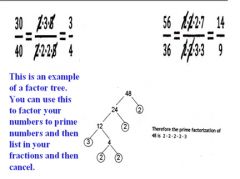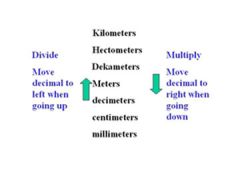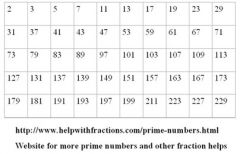![]()
![]()
![]()
Use LEFT and RIGHT arrow keys to navigate between flashcards;
Use UP and DOWN arrow keys to flip the card;
H to show hint;
A reads text to speech;
37 Cards in this Set
- Front
- Back
|
Divisibility Rules- Dividing Evenly
1. Every even number is divisible by "2" 2. Numbers ending in "0" or "5" or divisible by "5" 3. Any number that can be divided evenly by "10' has to end in "0". 4. If the last two digits in a number is divisible by "4" evenly, then the entire number can be divided by "4" evenly. 5. If the last three digits in a number can be divided by "8" evenly, then the entire number can be divided by "8" evenly. 6. Add all the digits together and if the sum can be divided by "3", then the entire number can be divided by "3" evenly. 7. Add all the digits together and if the sum can be divided by "9", the the entire number can be divided by "9" evenly. 8. If the number being divided is an even number and you add all the numbers together and the sum can be divided by "3" evenly, then the number can be divided by "6" evenly. |
blank
|
|
|
Equivalent Fractions are fractions where the numerator and denominator of the fraction are multiplied or divided by the same number.
Example if your fraction is 2/6 and you want to reduce the fraction. To keep the fraction the same equivalent you have to divide both numbers in the fraction by the same number so 2/6 ¸ 2/2= 1/3. The numbers in the fraction are different now but they are the same value as the first fraction. This is a Equivalent Fraction- If you change one number in your fraction you have to change the other by the same number. |
Blank
|
|
|
Definition - A prime number is defined as any number that can be divided, without a remainder, only by itself and by 1.
Zero and 1 are not considered prime. The only even prime number is 2. Any number where the "sum" of the digits add up to a number that is divisible by "3" is not prime. Example: The number 1,269 is not prime because the sum of the digits (1 + 2 + 6 + 9 = 18) and since "18" is evenly divisible by 3, the number 1,269 is NOT a prime number. Except for 0 and 1, a number is either a prime number or a composite number. A composite number is defined as any number, greater than 1, that is not prime. |
Blank
|
|
|
Adding and Subtracting Fractions
The fractions have to have common denominators before you can add or subtract fractions. You need to find the lowest common denominator and change your fraction to an equivalent fraction. Multiplying and Dividing Fractions You do not need common denominators to multiply or divide fractions. Note: When you divide fractions you have to turn the second fraction upside down and then multiply. This is called a reciprocal. Change a Mixed Fraction to a Improper Fraction Multiply the denominator of the fraction by the whole number and add numerator. Put the results over the denominator. |
Blank
|
|
|
Change a fraction to a Decimal
A decimal is based on the number in terms of tenths, hundredths, thousandths, etc. Make the denominator a power of 10 (10, 100, 1000, so) by multiplying it or dividing it. To Multiply make an equivalent fraction that has a denominator of base 10 (10, 100, 1000, etc). Then use place value to write the appropriate decimal. To Divide Divide the numerator (top number) by the denominator (bottom number). Place a decimal point after the numerator and attach as many zeros as necessary to handle the division. If the quotient does not come out evenly, follow any rounding instructions. |
Blank
|
|
|
Decimals
Adding and Subtracting Decimals- Line up decimals and zero to any empty spaces and bring down decimal point in answer. Multiplying Decimals- Do not need to line up just multiply as normal. Add up all decimal places and put that many places in your answer. Dividing Decimals- If there is a decimal in the divisor move it to make a whole number, but you also have to move the same place in the dividend. Put the decimal point in the answer directly above the point in the dividend. |
Blank
|
|
|
Moving Decimal Point
1. When multiplying a decimal by 10, 100, 1000, etc., move the decimal point in the number to the right as many places as there are 0's. 2. When dividing a decimal by 10, 100, 1000, etc., move the decimal point in the number to the left as many places as there are 0's. |
Blank
|
|
|
Turning a Remiander into a Decimal
1. Put a decimal after the number being divided (dividend) and write a 0 after it. 2. Put a decimal point directly above in the answer. 3. Keep dividing (and bring down more 0's) until you get a 0 remainder or round the number per instructions. |
Blank
|
|
|
Is & Of
"of" - in between the numbers you will multiply. "is" - in between the numbers you will divide. The "of" will be the bottom number and the "is" will be the top number. |
Blank
|
|
|
Percent
A percent is based on the number in terms of 100. To change a percent to a fraction. Place the number in the percent over 100 and reduce. To change percent to decimal take off percent sign and move the decimal place to the left twice. Before you do any type of math problem you have to take the percent sign off and change either to a decimal or a fraction. You can't do the math using the percent sign. When you have a fraction with a percent, change the fraction part to a decimal and then take off percent sign and move the decimal to the left twice. |
Blank
|
|
|
Conversions
1. When converting larger units to smaller units multiply. 2. When converting smaller units to larger units divide. Mile- 1,760 yards, 5,280 feet, 63,360 inches Yard- 1/1,760 mile, 3 feet, 36 inches Foot- 1/5,280 mile, 1/3 yard, 12 inches Inch- 1/63,360 mile, 1/36 yard, 1/12 foot Kilo- 10 hecto, 100 deka, 1,000 meter Hecto- 1/10 kilo, 10 deka, 100 meter Deka- 1/100 kilo, 1/10 hecto, 10 meter Meter- 1/1000 kilo, 1/100 hecto, 1/10 deka 1 inch= 2.54 cm 1.0936 yds= 1 meter 1 mile= 1.609 km |
Blank
|
|
|
Measuring Area and Volume
Area- Multiply Length by width Area Unit Common Conversions: The conversion factor is multiplied twice. Example: feet to inches you would have to multiply the conversion factor which is 12 twice- so it would be 12x12= 144. Now you can multiply/divide to get your new conversion measurement. If you have to skip a measurement, you would convert one measurement at a time. Area Unit Metric Conversions: The measurement is multiplied/divided by 100 for each measurement change. Or just move your decimal point 2 places for each measurement change. |
Blank
|
|
|
Measuring Area and Volume
Volume Measure: Multiply Length times Width times Height. This is cubic measure because it tells us the number of cubes that can fit in the area. Common Volume: Multiply the conversion factor 3 times. Example cubic foot to cubic inches 12x12x12= 1,728 cubic inches. Then you would multiply/divide that number to find your new conversion measurement. If you have to skip a measurement, you would convert one measurement at a time. 1 gallon = 4 quarts 1 quart = 2 pints 1 pint = 16 fluid ounces Metric Volume: Multiply 10x10x10=1,000 Each measurement change you would multiply/divide by 1,000 to find a cubic metric measure. |
Blank
|
|
|
Measuring Area and Volume
Metric measure for volume is in Liters: kiloliter hectoliter dekaliter liter deciliter centiliter milliliter To convert in liters you would multiply/divide by 10 for each measurement change. |
Blank
|
|
|
Equation
is two expression that have an equal sign between them |
Blank
|
|
|
Solving a Problem with Algebra
1. Make x stand for whatever you're trying to find. 2. Study the facts to find two things that must be equal; then write a word equation. 3. Turn the word equation into an algebra equation, with numbers and and x. 4. Find the solution which when put in for x makes both sides equal. 5. Interpret the meaning of the solution. |
Blank
|
|
|
Rewriting the expression
If you have two numbers added or multiplied, not matter what they are you are free to switch their position. But not in substraction or division. |
Blank
|
|
|
Golden Rule of Algebra
is that if we change the value of one side of an equation, we must change the other side by the same amount. Undoing the equation: Addition you subtract- Multiplication you divide- and vice versa. This is called inverse operations. |
Blank
|
|
|
Positive numbers have a "+" sign or just the number.
Negative numbers have a "-" sign in front of number. They are numbers less than zero. |
-10 negative number
10 positive number |
|
|
Positive numbers are on the right side of zero. Numbers get larger to the right of zero.
Negative numbers are on the left side of zero. Numbers get smaller to the left of the zero. Zero is neither negative or positive. There are negative fractions and decimals but whole numbers positive, negative or zero are called integers. |
Blank
|
|
|
Adding negative numbers
positive is a gain and negative is a loss.If the numbers (integers) are both positive, the sum is also positive. If the integers are both negative, the sum is also negative. If the integers have different signs, the sum will have the sign of the integer with the largest absolute value.Absolute value is when you take the positive/negative sign from the number and look at its value. |
4 - (-3) = 1
You had a gain but you also had a loss, so now you just have 1. 8 + (-10) = -2 you had a gain but a big loss |
|
|
Every number has an opposite, which is the same number with an opposite sign. Opposites are always the same distance from zero.
|
-3 and 3 have the numbers 1 and 2 between them and the zero.
|
|
|
Subtracting negatives
is taking away a loss and adding a gain (positive).Change the subtraction to addition and change the sign of the second number to its opposite and then add.If the numbers (integers) are both positive, the sum is also positive. If the integers are both negative, the sum is also negative. If the integers have different signs, the sum will have the sign of the number with the largest absolute value.Absolute value is when you take the positive/negative sign from the number and look at its value. |
3 - (-3) change 3 + 3 = 6
|
|
|
Multiplying with negative numbers
First multiply as normal Second now look at the signs and if: negative x positive= negative positive x negative= negative negative x negative= positive positive x positive= positive |
-3 x 3 = -9
3 x (-3) = -9 -3 x (-3) = 9 3 x 3 = 9 |
|
|
Division with negative numbers
First divide as normal Second now look at the signs and if: negative / positive= negative positive / positive= negative negative / negative= positive positive / positive= positive |
-4 / 2 = -2
4 / -2 = -2 -4 / -2 = 2 4 / 2 = 2 |
|
|
Undoing Addition with negative numbers
Instead of subtracting the negative number from both sides, add an opposite positive number to both sides. |
x + (-5) = 7 Change
x + (-5) + 5 = 7 + 5 |
|
|
Undoing Subtraction with negative numbers
Change the equation to addition and change the second number to its opposite sign. Add that number to the other side of the equation. |
x - (-3) = 8 Change
x + 3 = 8 + 3 |
|
|
Undoing division and multiplication with negative numbers.
Use same rules for undoing, but remember the rules for dividing and multiplying negative and positive numbers. |
If the signs are different it is a negative 4 / (-2) = -2
If the signs are the same it is a positive -4 / (-4) - 2 |
|
|
Negative numbers that can't be divided evenly
Option 1: Turn your division into a decimal and follow the rules for the correct negative/ positive sign and use in answer. Option 2: Leave as a fraction, and follow the rules for the correct positive/negative sign and use for the whole fraction |
3 / (-5) = -0.6
or 3 / (-5) = -3/5 |
|
|
When you need to switch "x" to another position in subtraction.
Change to addition by changing "x" to its opposite. However you have to change the "-x" back to "x". You do that by multiplying by -1 on both sides of equations. -1 multiplied by any number equals the number's opposite. |
8.1 - x = 13.7
Change -x + 8.1=13.7 -x = 5.6 -x(-1) = 5.6(-1) x= -5.6 |
|
|
-x in a fraction
Option 1: undo with multiplication and to get rid of -x multiply by -1 on both sides of equation. Option 2: Move the negative sign from the -x to the positive number in fraction. Now you have a regular x. Now just undo the division. |
-x/7.9 = -1.5
7.9 (-x/7.9) = (7.9)(-1.5) -x = -11.85 (-1)(-x) = (-1)(-11.85) x=11.85 -x/7.9 = -1.5 x/(-7.9) = -1.5 (-7.9)(x/-7.9) = (-7.9)(-1.5) x = 11.85 |
|
|
1. Factor the numerator and denominator into their respective prime factorizations.
2. Cancel all common factors exactly once. 3. Multiply the remaining factors in the numerator and the remaining factors in the denominator. |

|
|

|
Blank
|
|

|
Blank
|
|
|
Order of Operation Rules
|
All multiplications and divisions are don first.
All additions and subtractions are done second. If a different order is needed, the operations that are suppose to be done first must be in parentheses or inside a fraction. |
|
|
Undoing Two Operation Equations
Reverse order is only for undoing. |
Operations are always undone in the reverse order. That means whatever is done to the x last, we undo first.
|
|
|
Simplifying an expression
|
We can add in any order because additiong has a commutative property and an associative properth.
We can't subtract in any order. We can simplify by changing the subtraction to addition of the opposite. |

